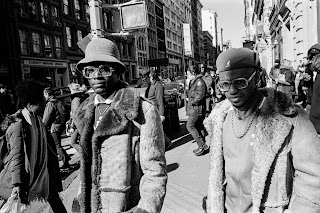people watching and street photography IV.
Rethinking the Flâneur: Flânerie and the Senses, Aimée Boutin
It is useful to distinguish the ‘popular’ from the
‘avant-garde’ flâneur: whereas the popular flâneur emerged in panoramic
literature and the commercial press, the avant-garde flâneur is more closely
associated with innovative artists. Charles Baudelaire identified the flâneur
with the artist and the imagination, against a scientific conception of
modernity. In contrast, Honoré de Balzac had conceived of flânerie as a
synthesis of empiricism, creativity, and science in a well-known passage of
Physiologie du marriage.
In ‘Le Peintre de la vie moderne’, Baudelaire
compares the flâneur to Poe’s ‘man of the crowd’. As he who chooses to dwell at
the centre of the movement of the crowd but who resists being sucked into it,
he remains disengaged, masterful, princely, invisible, superior, and
omniscient; but, as Krueger demonstrates in her rereading of this passage, the
man of the crowd not only observes the spectacle but he smells its effluvia.
Benjamin sought to define the modern stroller as the
avant-garde flâneur and based his understanding of the type on the
artist-flâneur. Martina Lauster (2007) has pointed out, Walter Benjamin largely
ignores the import of panoramic literature in shaping the type, consequently
undermining how these typologies thematized the process of observation. His
materialist interpretation of the flâneur emphasized the significance of the
new architectural visual aesthetic in Paris, notably the arcades or passages,
built in the first decades of 19th century, and the boulevards.
The new phenomenon of the boulevards and the urban
masses made the flâneur into a ‘man of the crowd’ whom Benjamin
counterintuitively interpreted as a person disconnected from the crowd. He cast
the flâneur as an oppositional figure whose pace and leisurely attitude protest
the industriousness of the marketplace.
continue/
- urban and architectural studies moved by the sensual
turn
- Baron Haussmann's design turned the street into an interior
- popular flâneur and panoramic literature / avant-garde flâneur and innovative artists
- Poe’s 'man of the crowd'
- aesthetic, urban perception as a specifically masculine phenomenon
- flâneuses


Comments
Post a Comment